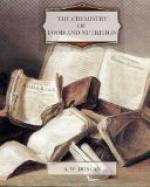Cookery.—Flesh is easier to digest raw. A few, on the advice of their doctors, eat minced raw flesh, raw beef juice and even fresh warm blood. Such practice is abhorrent to every person of refinement. Cooking lessens the offensive appearance and qualities of flesh and changes the flavour; thorough cooking also destroys any parasites that may be present. Raw flesh is more stimulating to the animal passions, and excites ferocity in both man and animals. If the old argument was valid, that as flesh is much nearer in composition and quality to our own flesh and tissues, it is therefore our best food, we do wrong in coagulating the albuminoids, hardening the muscle substance and scorching it by cooking.
Fruits when ripe and in good condition are best eaten raw; cooking spoils the flavour. Food requiring mastication and encouraging insalivation is the best. Food is frequently made too sloppy or liquid, and is eaten too hot, thus favouring indigestion and decay of the teeth. The cereals and pulses can only with difficulty be eaten raw. When cooked in water the starch granules swell and break up, the plant cells are ruptured, the fibres are separated and the nutritious matter rendered easy of digestion. The flavour is greatly improved. Cooking increases our range and variety of food. The civilised races use it to excess and over-season their dishes, favouring over-eating.
If baking powders are used they should only be of the best makes. They should be composed of sodium bicarbonate and tartaric acid, in such correct proportions that upon the addition of water only sodium tartrate and carbon dioxide (carbonic acid) should result. Some powders contain an excess of sodium bicarbonate. Self-raising flours should be avoided. They are commonly composed of—in addition to sodium




